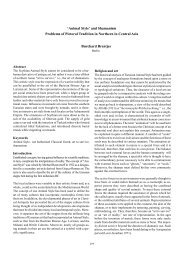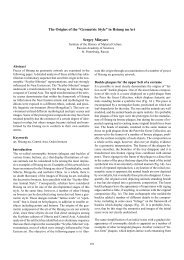Part II Archaeological Excavations - Center for the Study of Eurasian ...
Part II Archaeological Excavations - Center for the Study of Eurasian ...
Part II Archaeological Excavations - Center for the Study of Eurasian ...
Create successful ePaper yourself
Turn your PDF publications into a flip-book with our unique Google optimized e-Paper software.
Kurgans, Ritual Sites, and Settlements: <strong>Eurasian</strong> Bronze and Iron Age<br />
Settlements and kurgans provide abundant materials <strong>for</strong> <strong>the</strong><br />
reconstruction <strong>of</strong> <strong>the</strong> Sargat society architectural patterns. A<br />
relatively high level <strong>of</strong> spatial organization, planning, house<br />
and <strong>for</strong>tification construction corresponded to <strong>the</strong> specific environmental<br />
conditions (Fig. 7). Wood was <strong>the</strong> basic material<br />
<strong>for</strong> funerary and residential construction. Types <strong>of</strong> houses varied<br />
between small and light dwellings, such as at Malokazakhbayevo,<br />
to large and multi-roomed houses with approximately<br />
100 sq m, and having several hearths and internal economic<br />
areas. Complex houses <strong>of</strong> this type are known at Prygovo<br />
and Pavlinovo.<br />
Some aspects <strong>of</strong> mortuary practice<br />
Comparison <strong>of</strong> settlements and cemeteries reveals a discrepancy<br />
from <strong>the</strong> point <strong>of</strong> view <strong>of</strong> <strong>the</strong>ir demographic potential.<br />
The number <strong>of</strong> burials and <strong>the</strong> demographic composition <strong>of</strong><br />
burial grounds do not correspond to <strong>the</strong> probable number <strong>of</strong><br />
settlement inhabitants. This observation provided a new hypo<strong>the</strong>sis<br />
concerning <strong>the</strong> possibility <strong>of</strong> alternative funerary practices<br />
that did not include a kurgan. Indirect arguments in favor<br />
<strong>of</strong> this hypo<strong>the</strong>sis are represented by <strong>the</strong> occurrence <strong>of</strong> occasional<br />
flat burials located outside kurgan mounds. This hypo<strong>the</strong>sis<br />
will be tested by fur<strong>the</strong>r research.<br />
Detailed analysis <strong>of</strong> funerary rituality revealed several patterns<br />
relating to <strong>the</strong> different chronological time periods and different<br />
social gradations. Barrows covered <strong>the</strong> burials; this architecture<br />
included a circular or polygonal ditched enclosure that<br />
served to delimit <strong>the</strong> mortuary area. Ditches usually correlated<br />
with <strong>the</strong> different phases <strong>of</strong> barrow construction. The size, construction,<br />
and number <strong>of</strong> burials varied between kurgans. Large<br />
mounds, approximately 100 m in diameter, usually dominated<br />
<strong>the</strong> high riverbanks, and towered over o<strong>the</strong>r kurgans. A good<br />
example <strong>of</strong> such a cemetery is <strong>the</strong> Scaty burial ground that<br />
contained kurgans that reveal it to have had an aristocratic character.<br />
The funerary ceremony also included some actions connected<br />
with animal sacrifices and food <strong>of</strong>ferings. Each kurgan<br />
contained several burials (Fig. 8). As a rule, <strong>the</strong> first and second<br />
central burials in a cemetery were primary, while later dated<br />
burials were arranged around <strong>the</strong> periphery.<br />
Grave pits were <strong>of</strong> two types: (1) those with straight vertical<br />
walls and (2) those with ledges cut into <strong>the</strong> walls. In some pits<br />
<strong>the</strong>re was evidence <strong>of</strong> wooden pillars supporting an upper covering,<br />
and <strong>the</strong> burial chambers reflected some <strong>of</strong> <strong>the</strong> elements<br />
belonging to a house. Special c<strong>of</strong>fins or litters were employed<br />
in <strong>the</strong> burials. Accompanying grave goods reflected <strong>the</strong> social<br />
and pr<strong>of</strong>essional status <strong>of</strong> <strong>the</strong> deceased, who were buried in an<br />
extended position, and were generally oriented to <strong>the</strong> north.<br />
An integral part <strong>of</strong> <strong>the</strong> mortuary assemblage was food <strong>of</strong>ferings–pieces<br />
<strong>of</strong> horsemeat and vessels that contained milk or<br />
broth. Horse, cattle, and sheep meat were consumed during <strong>the</strong><br />
funeral feast and <strong>the</strong>ir remains have been found outside <strong>the</strong><br />
grave pit. Male burials clearly expressed warrior characteristics.<br />
Weapons could accompany a 12–14 year old (Fig. 12),<br />
<strong>the</strong>reby shedding light on <strong>the</strong> age group system that existed<br />
within Sargat society. Females were buried with ornaments,<br />
68<br />
including beads and earrings, as well as tools associated with<br />
textile production, and various vessels including bronze cauldrons<br />
(Fig. 9) and stone plates. Fire appears to have played an<br />
important role in <strong>the</strong> funerary ceremonies.<br />
The central burials invariably belonged to major personages.<br />
Their pits were much larger than those on <strong>the</strong> periphery and<br />
<strong>the</strong>y contained more imposing wooden constructions, including<br />
large upper ro<strong>of</strong>ed areas (Koryakova 1988;<br />
Koryakova and Daire 1997).<br />
Anthropological analysis<br />
A component <strong>of</strong> <strong>the</strong> project focuses upon <strong>the</strong> examination <strong>of</strong><br />
human remains. Various methods <strong>of</strong> physical examination were<br />
undertaken to enable <strong>the</strong> reconstruction <strong>of</strong> <strong>the</strong> age and sex pr<strong>of</strong>ile<br />
<strong>of</strong> <strong>the</strong> population. Muscle markings were analyzed to assess<br />
<strong>the</strong> types <strong>of</strong> human activity which were undertaken by <strong>the</strong><br />
deceased during <strong>the</strong>ir everyday life. It is difficult to syn<strong>the</strong>size<br />
<strong>the</strong> health <strong>of</strong> this population because <strong>the</strong> majority <strong>of</strong> burials<br />
had been robbed, resulting in <strong>the</strong> disturbance <strong>of</strong> <strong>the</strong> skeletons<br />
that were frequently incomplete. Thus, our sample is not large<br />
and does not include <strong>the</strong> entire population. Never<strong>the</strong>less, we<br />
observed a significant prevalence <strong>of</strong> porotic hyperostosis, cribra<br />
orbitalia, or thickness <strong>of</strong> <strong>the</strong> diploe, lesions which are indicative<br />
<strong>of</strong> a high frequency <strong>of</strong> anemia. Enamel hypoplasia was<br />
also relatively frequent as was osteoarthritis that was especially<br />
observed on <strong>the</strong> vertebral column (Fig. 10). Muscular activity<br />
was relatively high, and <strong>the</strong> insertions <strong>of</strong> <strong>the</strong> main muscles are<br />
well developed, a condition <strong>of</strong>ten associated with en<strong>the</strong>sopathies.<br />
These were <strong>the</strong> main pathologies encountered. Very<br />
few traumatic lesions were observed, which would contradict<br />
a military characteristic <strong>for</strong> <strong>the</strong> Sargat society. The clearly expressed<br />
marker <strong>of</strong> a horse rider’s pathological complex is indicated<br />
in some male burials (Fig. 11), but, it should be noted<br />
that <strong>for</strong> <strong>the</strong> most part, <strong>the</strong> deceased could not be described as<br />
being involved in extreme nomadic activity, although <strong>the</strong>y frequently<br />
rode horses (Courtaud and Rajev 1997).<br />
The majority <strong>of</strong> <strong>the</strong> investigated burials were <strong>of</strong> adult personages.<br />
Males and females died at a relatively young age, not<br />
corresponding to <strong>the</strong> expected normal mortality rate. The sample<br />
was too small, however, to enable a proper demographic pr<strong>of</strong>ile<br />
to be reconstructed <strong>for</strong> <strong>the</strong> population. Thirty-four subjects<br />
were excavated - 5 children and 29 adults. We would expect<br />
<strong>for</strong> this time period and <strong>the</strong> probable birth-life expectancy, that<br />
we would find approximately 50 percent adults and 50 percent<br />
immature individuals. Thus, a large quantity <strong>of</strong> immature individuals<br />
was not found–with one exception. Three children and<br />
an equal number <strong>of</strong> adults were excavated from <strong>the</strong> Skaty Cemetery.<br />
Among <strong>the</strong> adult individuals, we encountered 14 males,<br />
5 females and 10 <strong>of</strong> indeterminable sex due to <strong>the</strong>ir incomplete<br />
skeletons.<br />
Conclusions<br />
The Sargat settlement sites provided abundant material culture<br />
which enabled <strong>the</strong> determination <strong>of</strong> <strong>the</strong> economic bases, environment,<br />
architecture, and <strong>the</strong> stylistic traditions used in pottery<br />
manufacture. These artifacts allowed <strong>the</strong> chronological and





